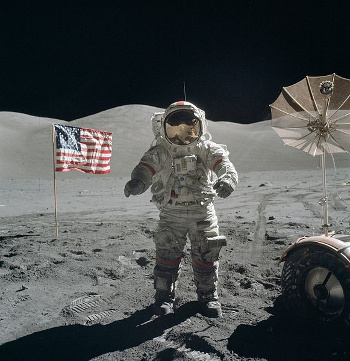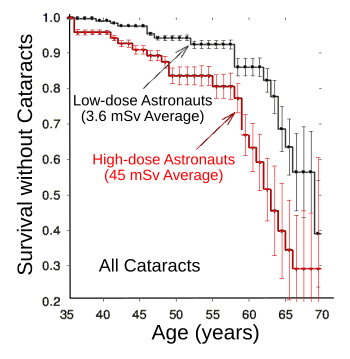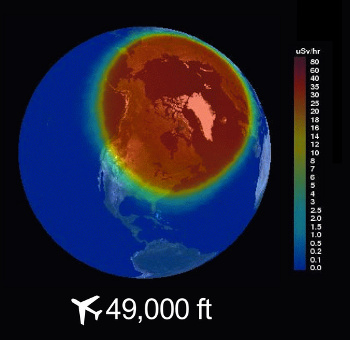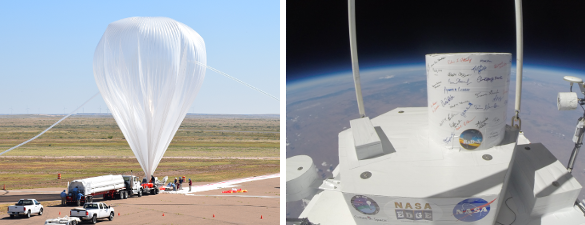High Altitude Radiation
March 2, 2017
Boeing introduced a new
space suit design on January 25, 2017.[1] Space suits are a reminder that the only way that
humans can survive in
space is to take our
earthly environment with us. Space suit design is quite closely coupled with
materials science, since it's the rapid pace of materials
development that's allowed the evolution of space suits from the bulky affairs that resemble
robot exoskeletons to the lightweight suits of the present day.

Apollo 17 astronaut, Eugene Cernan, on the Moon, December 13, 1972.
Cernan and companion astronaut, Harrison Schmitt, were in the Moon's Taurus–Littrow valley for about 75 hours.
(NASA photo by astronaut, Harrison H. Schmitt, via Wikimedia Commons.)
While space suits and
spacecraft provide a
breathable atmosphere, sufficient
atmospheric pressure, and protection from the cold of space, they don't
shield against high
intensity radiation. Astronauts first noticed this as
random flashes of light caused by cosmic rays.
Cosmic rays are
protons and
atomic nuclei zipping through space at
energies up to the range of 10
20 electronvolts (eV), which is several
joules.
On
lunar missions, the
Apollo astronauts reported these flashes about once every three minutes, and other astronauts in Earth
orbit have seen these about half as often. Such events were transient and sometimes annoying, but a more significant result is that a 2001 study showed a higher incidence of
cataracts in former astronauts who have flown in space, some cataracts having appeared as soon as 4-5 years after the missions.[2]
There was a higher risk of cataracts at
lens doses greater than 8
mSv than for lower does. The radiation appears to greatly increase the activity of
Fibroblast Growth Factor 2 (FGF-2) that leads to the formation of abnormal fiber
cells and cataracts.[3] Such a finding is important if we intend to send travellers to
Mars, a journey that could take six months to a year. There's also the problem of cosmic ray exposure on Mars, which does not have a
magnetosphere and an atmosphere for cosmic ray shielding.

Incidence of cataracts for NASA astronauts as a function of age.
The radiation dose effect is clearly evident, and getting cataracts in your thirties is unusual for ordinary people.
(Created with Inkscape from data in ref. 4.[4]
While it's unlikely that many of us will be astronauts, or will have enough money to be
space tourists, ordinary people are exposed to cosmic radiation through
air travel, and the
crew of aircraft, who do much more air travel, are exposed even more. The cosmic ray
flux increases significantly with
altitude, a
phenomenon discovered by
physicist,
Victor Hess, in a
balloon flight experiment in 1912. Hess found a four-fold increase in cosmic ray flux at an altitude of 5,300
meters (17,000
feet), a discovery that resulted in his
Nobel Prize in Physics in 1936. There's about a seven-fold increase at 10,000 meters (33,000 feet), which is less than the typical
cruising altitude for a passenger aircraft.
Hess did his balloon experiment near the time of a
near-total solar eclipse to ensure that the radiation that he measured came from sources other then the
Sun. As can be seen from the figure, Hess's idea that the Sun at times can dump significant radiation onto the Earth was correct. The Earth's magnetosphere protects our planet by deflecting the
solar wind around it, but it's less effective at the
poles, as the
aurora (northern lights) attests. Aircraft travelling
great-circle routes over the
North Pole will at times be exposed to greater radiation.

Radiation at the North Pole at aircraft cruising altitude after a 2003 solar storm.
The Earth's magnetosphere offers less radiation protection at the poles.
(Portion of a NASA/NAIRAS image.)
NASA's Radiation Dosimetry Experiment (RaD-X) is a
stratospheric balloon flight mission designed to provide a basis for real-time monitoring of radiation exposure at high altitude to assist in route planning for aircraft.[5-7] Balloon-launched
instrument packages characterize both cosmic ray primary, and
cosmic ray secondary radiation, at aviation altitudes.[5] Secondary radiation is produced when cosmic ray particles strike
nitrogen and
oxygen nuclei in the
atmosphere to produce cascades of
particles and
photons. These secondary rays peak at about 60,000 feet, a region known as the
Pfotzer maximum.[6]
RaD-X was launched from
Fort Sumner, New Mexico, on September 25, 2015, and it collected more than eighteen hours of radiation data using four different types of
dosimeters at altitudes from 26,000 to over 120,000 feet.[5-6] Companion measurements were conducted on
NASA's ER-2 aircraft and commercial aircraft to assess the potential of aircraft to monitor the aircraft radiation environment.[5] Says Chris Mertens,
principal investigator of the RaD-X mission at
NASA's Langley Research Center (Hampton, Virginia),
"The measurements, for the first time, were taken at seven different altitudes, where the physics of dosimetry is very different... By having the measurements at these seven altitudes we're really able to test how well our models capture the physics of cosmic radiation."[6]

Left, a RaD-X balloon launch at Fort Sumner, New Mexico. The RaD-X instrument packages is shown on the right. (Left, NASA image by Christopher Mertens. Right image by NASA.)
Data from the RaD-X program will be used in development of NASA's
Automated Radiation Measurements for Aerospace Safety program that will use instruments flown aboard commercial aircraft to do real-time monitoring at high altitudes.[6] Since the standard instrument for such monitoring, the
Tissue Equivalent Proportional Counter (TEPC), is too large and expensive, the RaD-X mission is testing smaller,
solid state instruments for this purpose.[6] Radiation data will be used to improve the
Nowcast of Atmospheric Ionizing Radiation for Aviation Safety (NAIRAS) space weather model, whose predictions allow rerouting of aircraft when necessary.[8-9]
References:
- Loren Grush, "Riding to space in style," The Verge, January 25, 2017.
- F. A. Cucinotta, F. K. Manuel, J. Jones, G. Iszard, J. Murrey, B. Djojonegro, and M. Wear, "Space Radiation and Cataracts in Astronauts," Radiation Research, vol. 156, no. 5 (November, 2001), pp. 460-466.
- Blinding Flashes, NASA Web Site, October 22, 2004.
- Francis A. Cucinotta, "Space Radiation Risks for Exploration," National Academies of Sciences Web Site, May 30, 2013.
- Christopher J. Mertens, "Overview of the Radiation Dosimetry Experiment (RaD-X) flight mission," Space Weather, vol. 14, No. 11 (November, 2016), pp. 921-934, DOI: 10.1002/2016SW001399.
- Mara Johnson-Groh, "NASA Studies Cosmic Radiation to Protect High-Altitude Travelers," NASA Web Site, January 27, 2017.
- NASA RaD-X mission Web Site.
- Video: Radiation dose rates of NAIRAS model for November 14, 2012, 20:00-21:00 GMT, NASA/NAIRAS.
- Nowcast of Atmospheric Ionizing Radiation System.
Permanent Link to this article
Linked Keywords: Boeing; space suit; human; outer space; earthly; environment; materials science; research and development; robot; exoskeleton; Apollo 17; astronaut; Eugene Cernan; Moon; Harrison Schmitt; Taurus–Littrow valley; Wikimedia Commons; spacecraft; breathing; atmosphere; atmospheric pressure; radiation protection; shield; intensity; radiation; random; cosmic ray visual phenomena; flashes of light caused by cosmic rays; cosmic ray; proton; atomic nucleus; atomic nuclei; energy; electronvolt; joule; lunar; Apollo program; orbit; cataract; lens; absorbed dose; Sievert; mSv; Fibroblast Growth Factor 2 (FGF-2); cell; Mars; magnetosphere; NASA; Inkscape; space tourism; space tourist; air travel; aircrew; crew; flux; altitude; phenomenon; physicist; Victor Hess; balloon flight; experiment; meter; foot; feet; Nobel Prize in Physics; cruising altitude; total solar eclipse; Sun; solar wind; geographical pole; aurora; great-circle navigation; great-circle route; North Pole; Halloween solar storms, 2003; Radiation Dosimetry Experiment (RaD-X); stratosphere; stratospheric; instrumentation; instrument package; air shower; cosmic ray secondary radiation; nitrogen; oxygen; atmosphere; subatomic particle; photon; Pfotzer maximum; Fort Sumner, New Mexico; dosimeter; NASA's ER-2 aircraft; principal investigator; Langley Research Center (Hampton, Virginia); physics; dosimetry; data; Automated Radiation Measurements for Aerospace Safety program; Tissue Equivalent Proportional Counter (TEPC); solid state; Nowcast of Atmospheric Ionizing Radiation for Aviation Safety (NAIRAS).